dimensions Alfa Romeo MiTo 2021 Owner handbook (in English)
[x] Cancel search | Manufacturer: ALFA ROMEO, Model Year: 2021, Model line: MiTo, Model: Alfa Romeo MiTo 2021Pages: 212, PDF Size: 5.18 MB
Page 69 of 212
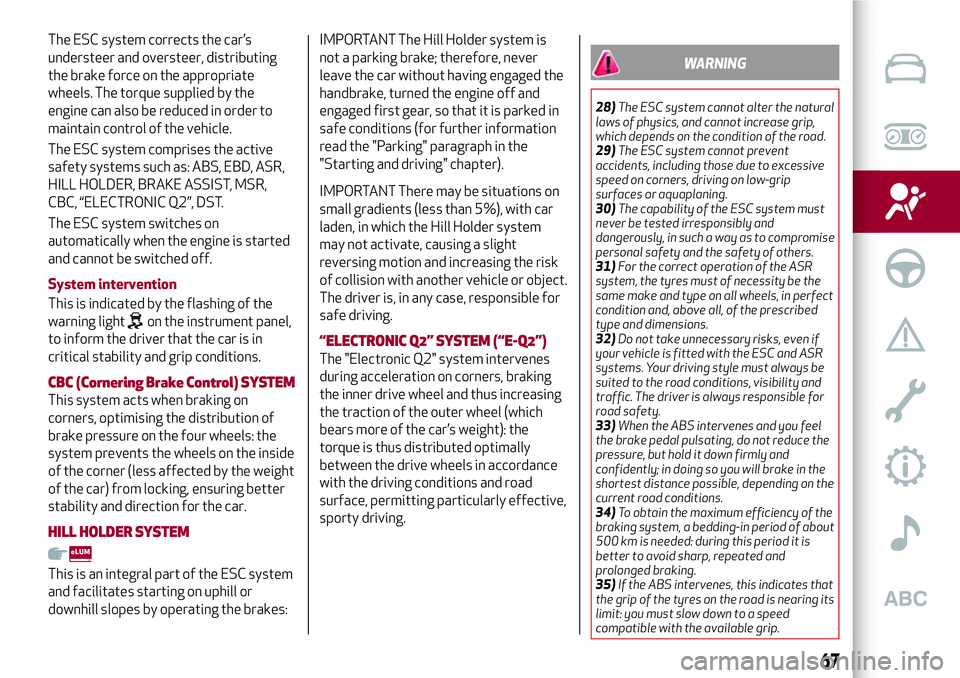
The ESC system corrects the car’s
understeer and oversteer, distributing
the brake force on the appropriate
wheels. The torque supplied by the
engine can also be reduced in order to
maintain control of the vehicle.
The ESC system comprises the active
safety systems such as: ABS, EBD, ASR,
HILL HOLDER, BRAKE ASSIST, MSR,
CBC, “ELECTRONIC Q2”, DST.
The ESC system switches on
automatically when the engine is started
and cannot be switched off.
System intervention
This is indicated by the flashing of the
warning light
on the instrument panel,
to inform the driver that the car is in
critical stability and grip conditions.
CBC (Cornering Brake Control)SYSTEM
This system acts when braking on
corners, optimising the distribution of
brake pressure on the four wheels: the
system prevents the wheels on the inside
of the corner (less affected by the weight
of the car) from locking, ensuring better
stability and direction for the car.
HILL HOLDERSYSTEM
This is an integral part of the ESC system
and facilitates starting on uphill or
downhill slopes by operating the brakes:
IMPORTANT The Hill Holder system is
not a parking brake; therefore, never
leave the car without having engaged the
handbrake, turned the engine off and
engaged first gear, so that it is parked in
safe conditions (for further information
read the "Parking" paragraph in the
"Starting and driving" chapter).
IMPORTANT There may be situations on
small gradients (less than 5%), with car
laden, in which the Hill Holder system
may not activate, causing a slight
reversing motion and increasing the risk
of collision with another vehicle or object.
The driver is, in any case, responsible for
safe driving.
“ELECTRONIC Q2”SYSTEM (“E-Q2”)
The "Electronic Q2" system intervenes
during acceleration on corners, braking
the inner drive wheel and thus increasing
the traction of the outer wheel (which
bears more of the car’s weight): the
torque is thus distributed optimally
between the drive wheels in accordance
with the driving conditions and road
surface, permitting particularly effective,
sporty driving.
WARNING
28)The ESC system cannot alter the natural
laws of physics, and cannot increase grip,
which depends on the condition of the road.
29)The ESC system cannot prevent
accidents, including those due to excessive
speed on corners, driving on low-grip
surfaces or aquaplaning.
30)The capability of the ESC system must
never be tested irresponsibly and
dangerously, in such a way as to compromise
personal safety and the safety of others.
31)For the correct operation of the ASR
system, the tyres must of necessity be the
same make and type on all wheels, in perfect
condition and, above all, of the prescribed
type and dimensions.
32)Do not take unnecessary risks, even if
your vehicle is fitted with the ESC and ASR
systems. Your driving style must always be
suited to the road conditions, visibility and
traffic. The driver is always responsible for
road safety.
33)When the ABS intervenes and you feel
the brake pedal pulsating, do not reduce the
pressure, but hold it down firmly and
confidently; in doing so you will brake in the
shortest distance possible, depending on the
current road conditions.
34)To obtain the maximum efficiency of the
braking system, a bedding-in period of about
500 km is needed: during this period it is
better to avoid sharp, repeated and
prolonged braking.
35)If the ABS intervenes, this indicates that
the grip of the tyres on the road is nearing its
limit: you must slow down to a speed
compatible with the available grip.
67
Page 70 of 212
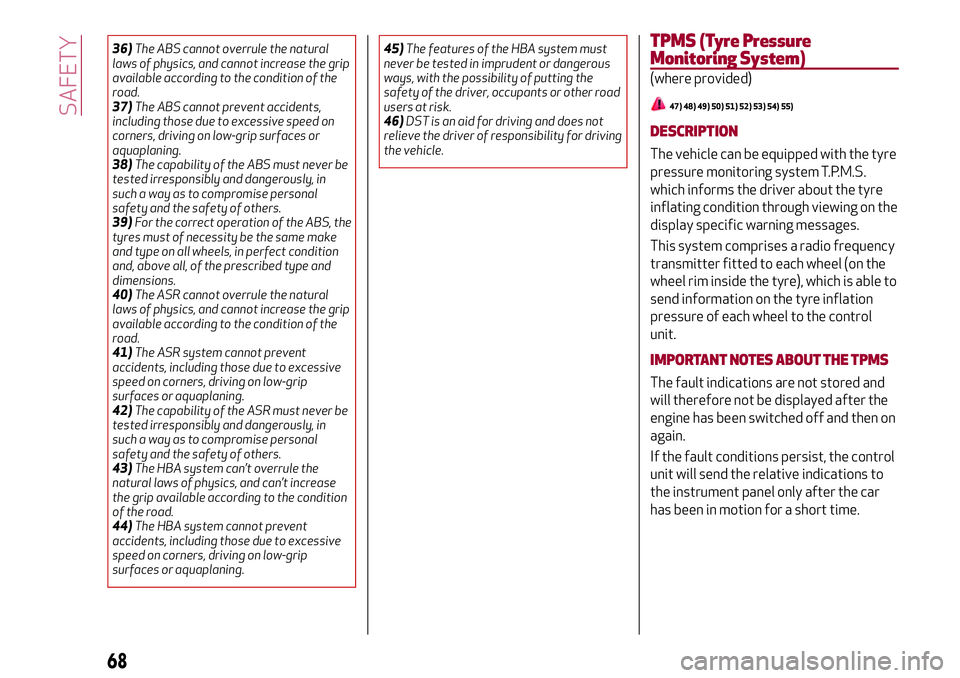
36)The ABS cannot overrule the natural
laws of physics, and cannot increase the grip
available according to the condition of the
road.
37)The ABS cannot prevent accidents,
including those due to excessive speed on
corners, driving on low-grip surfaces or
aquaplaning.
38)The capability of the ABS must never be
tested irresponsibly and dangerously, in
such a way as to compromise personal
safety and the safety of others.
39)For the correct operation of the ABS, the
tyres must of necessity be the same make
and type on all wheels, in perfect condition
and, above all, of the prescribed type and
dimensions.
40)The ASR cannot overrule the natural
laws of physics, and cannot increase the grip
available according to the condition of the
road.
41)The ASR system cannot prevent
accidents, including those due to excessive
speed on corners, driving on low-grip
surfaces or aquaplaning.
42)The capability of the ASR must never be
tested irresponsibly and dangerously, in
such a way as to compromise personal
safety and the safety of others.
43)The HBA system can’t overrule the
natural laws of physics, and can’t increase
the grip available according to the condition
of the road.
44)The HBA system cannot prevent
accidents, including those due to excessive
speed on corners, driving on low-grip
surfaces or aquaplaning.45)The features of the HBA system must
never be tested in imprudent or dangerous
ways, with the possibility of putting the
safety of the driver, occupants or other road
users at risk.
46)DST is an aid for driving and does not
relieve the driver of responsibility for driving
the vehicle.TPMS (Tyre Pressure
Monitoring System)
(where provided)
47) 48) 49) 50) 51) 52) 53) 54) 55)
DESCRIPTION
The vehicle can be equipped with the tyre
pressure monitoring system T.P.M.S.
which informs the driver about the tyre
inflating condition through viewing on the
display specific warning messages.
This system comprises a radio frequency
transmitter fitted to each wheel (on the
wheel rim inside the tyre), which is able to
send information on the tyre inflation
pressure of each wheel to the control
unit.
IMPORTANT NOTES ABOUT THE TPMS
The fault indications are not stored and
will therefore not be displayed after the
engine has been switched off and then on
again.
If the fault conditions persist, the control
unit will send the relative indications to
the instrument panel only after the car
has been in motion for a short time.
68
SAFETY
Page 153 of 212
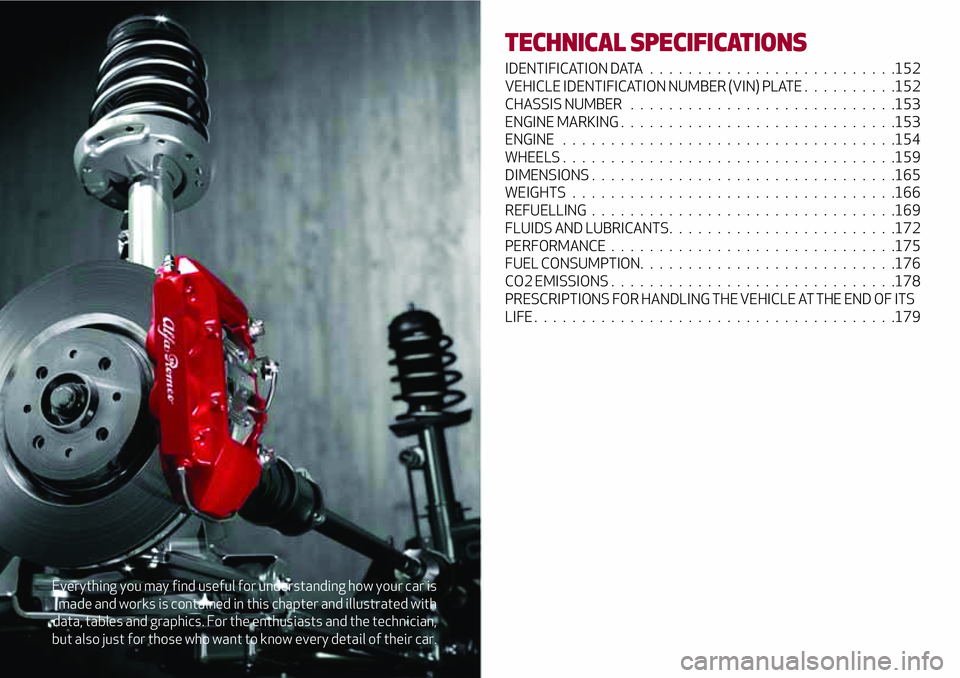
Everything you may find useful for understanding how your car is
made and works is contained in this chapter and illustrated with
data, tables and graphics. For the enthusiasts and the technician,
but also just for those who want to know every detail of their car.
TECHNICAL SPECIFICATIONS
IDENTIFICATION DATA..........................152
VEHICLE IDENTIFICATION NUMBER (VIN) PLATE . . . . ......152
CHASSIS NUMBER . . . . . .......................153
ENGINE MARKING . . . . . ........................153
ENGINE...................................154
WHEELS...................................159
DIMENSIONS . . ..............................165
WEIGHTS..................................166
REFUELLING................................169
FLUIDS AND LUBRICANTS. . . .....................172
PERFORMANCE . . . . . . . . . . . . . .................175
FUEL CONSUMPTION. . . . . ......................176
CO2 EMISSIONS . . . . ..........................178
PRESCRIPTIONS FOR HANDLING THE VEHICLE AT THE END OF ITS
LIFE......................................179
Page 167 of 212
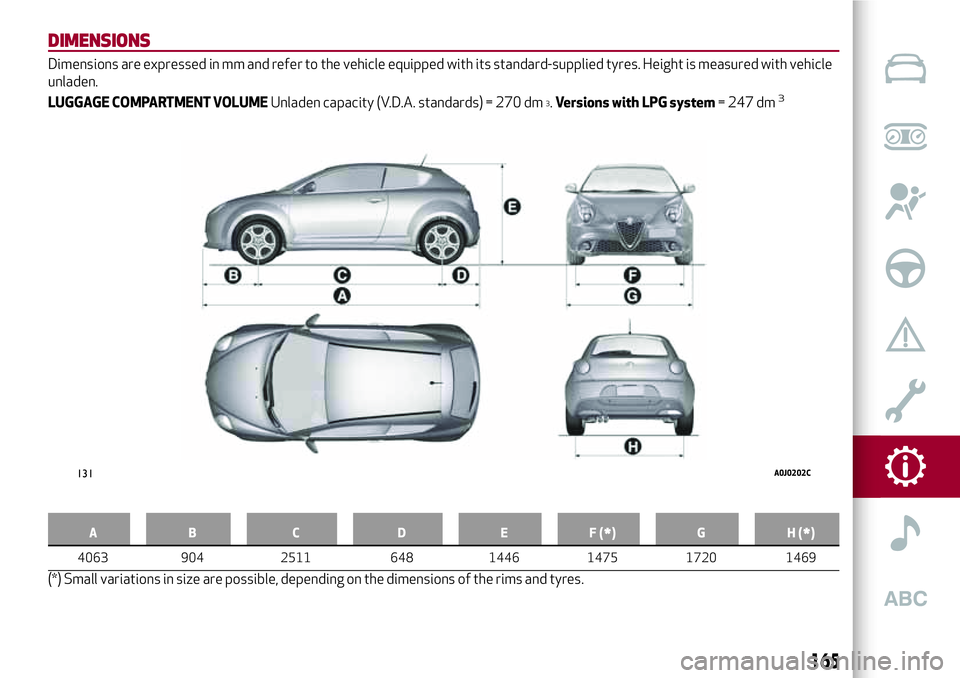
DIMENSIONS
Dimensions are expressed in mm and refer to the vehicle equipped with its standard-supplied tyres. Height is measured with vehicle
unladen.
LUGGAGE COMPARTMENT VOLUMEUnladen capacity (V.D.A. standards) = 270 dm
3.Versions with LPG system= 247 dm3
A B C D E F (*) G H (*)
4063 904 2511 648 1446 1475 1720 1469
(*) Small variations in size are possible, depending on the dimensions of the rims and tyres.
131A0J0202C
165
Page 207 of 212
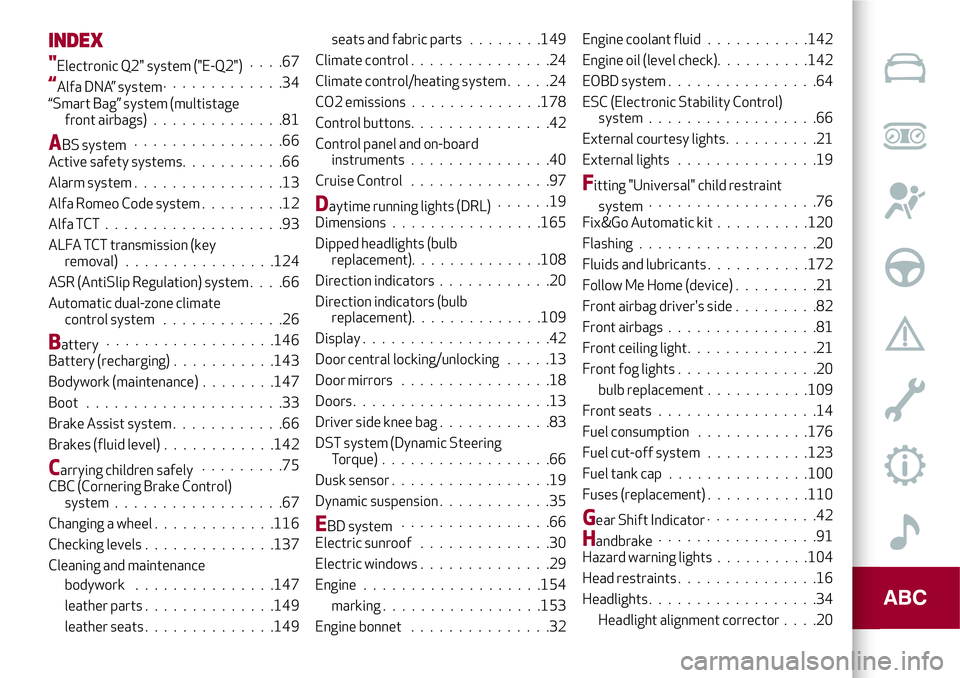
INDEX
"Electronic Q2" system ("E-Q2")....67
“Alfa DNA” system.............34
“Smart Bag” system (multistage
front airbags)..............81
ABS system................66
Active safety systems...........66
Alarm system................13
Alfa Romeo Code system.........12
Alfa TCT ...................93
ALFA TCT transmission (key
removal) ................124
ASR (AntiSlip Regulation) system....66
Automatic dual-zone climate
control system.............26
Battery..................146
Battery (recharging)...........143
Bodywork (maintenance)........147
Boot . . ...................33
Brake Assist system............66
Brakes (fluid level)............142
Carrying children safely.........75
CBC (Cornering Brake Control)
system..................67
Changing a wheel.............116
Checking levels..............137
Cleaning and maintenance
bodywork...............147
leather parts..............149
leather seats..............149seats and fabric parts........149
Climate control...............24
Climate control/heating system.....24
CO2 emissions..............178
Control buttons...............42
Control panel and on-board
instruments...............40
Cruise Control...............97
Daytime running lights (DRL)......19
Dimensions................165
Dipped headlights (bulb
replacement)..............108
Direction indicators............20
Direction indicators (bulb
replacement)..............109
Display....................42
Door central locking/unlocking.....13
Door mirrors................18
Doors.....................13
Driver side knee bag............83
DST system (Dynamic Steering
Torque)..................66
Dusk sensor.................19
Dynamic suspension............35
EBD system................66
Electric sunroof..............30
Electric windows..............29
Engine...................154
marking.................153
Engine bonnet...............32Engine coolant fluid . ..........142
Engine oil (level check)..........142
EOBD system ................64
ESC (Electronic Stability Control)
system . . . ...............66
External courtesy lights . . . . . .....21
External lights . . .............19
Fitting "Universal" child restraint
system..................76
Fix&Go Automatic kit..........120
Flashing . ..................20
Fluids and lubricants . ..........172
Follow Me Home (device) . ........21
Front airbag driver's side . ........82
Front airbags ................81
Front ceiling light . . . . ..........21
Front fog lights . . .............20
bulb replacement . ..........109
Front seats . . . . .............14
Fuel consumption............176
Fuel cut-off system . ..........123
Fuel tank cap . . . . . ..........100
Fuses (replacement) . ..........110
Gear Shift Indicator............42
Handbrake.................91
Hazard warning lights..........104
Head restraints . . .............16
Headlights..................34
Headlight alignment corrector . . . .20